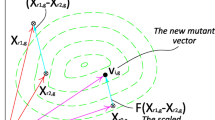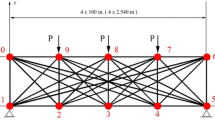Abstract
This paper deals with the weight minimization of planar steel trusses by adopting a differential evolution-based algorithm. Square hollow sections are considered. The design optimization refers to size, shape and topology. The design variables are represented by the geometrical dimensions of the cross sections of the different components of the truss, directly involving the size of the structure, and by some geometrical parameters affecting the outer shape of the truss. The topology is included in the optimization search in a particular way, since the designer at different runs of the algorithm can change the number of bays keeping constant the total length of the truss, to successively choose the best optimal solution. The minimum weight optimum design is posed as a single-objective optimization problem subject to constraints formulated in accordance with the current Eurocode 3. The optimal solution is obtained by a Differential Evolutionary (DE) algorithm. In the DE algorithm, a particular combination of mutation and crossover operators is adopted in order to achieve the best solutions and a specific way for dealing with constraints is introduced. The effectiveness of the proposed approach is shown with reference to two case-studies. The analysis results prove the versatility of the optimizer algorithm with regard to the three optimization categories of sizing, shape, topology as well as its high computational performances and its efficacy for practical applications. In particular useful practical indications concerning the geometrical dimensions of the various involved structural elements can be deduced by the optimal solutions: in a truss girder the cross section of the top chord should be bigger than the one of the bottom chord as well as diagonals should be characterized by smaller cross sections with respect to the top and bottom chords in order to simultaneously optimize the weight and ensure an optimal structural behaviour.
Similar content being viewed by others
References
Adeli, H. and Cheng, N. T. (1993). “Integrated genetic algorithm for optimization of space structures.” J. Aerosp Eng., 6(4), pp. 315–328.
Adeli, H. and Cheng, N. T. (1994). “Augmented Lagrangian genetic algorithm for structural optimization.” J. Aerosp Eng., 7(1), pp. 104–118.
Ashlock, D. (2006). Evolutionary computation for modeling and optimization. Springer, New York.
Brencich, A. and Gambarotta, L. (2009). “Assessment procedure and rehabilitation of riveted railway girders: The Campasso Bridge.” Engineering Structures, 31, pp. 224–239.
British Standards Institution (2006). Eurocode 3: Design of Steel Structures- Part 1-5: Plated structural elements. BSI, London.
Coello, C. A. and Christiansen, A. D. (2000). “Multiobjective optimization of trusses using genetic algorithms.” Computers and Structures, 75(6), pp. 647–660.
Dauner, H.-G., Oribasi, A., and Wery, D. (1998). “Lully viaduct, a composite bridge with steel tube truss.” Journal of Constructional Steel Research, 46(1–3), pp. 67–78.
Deb, K. and Gulati, S. (2001). “Design of truss-structures for minimum weight using genetic algorithms.” Finite Elements in Analysis and Design, 37(5), pp. 447–465.
Fiore, A., Berardi, L., and Marano, G. C. (2012). “Predicting torsional strength of RC beams by using Evolutionary Polynomial Regression.” Advances in Engineering Software, 47, pp. 178–187.
Fiore, A., Monaco, P., and Raffaele, D. (2012). “Viscoelastic behaviour of non-homogeneous variable-section beams with post-poned restraints.” Computers and Concrete, 9(5), pp. 375–392.
Fiore, A., Marano, G. C., and Monaco, P. (2013a). “Earthquake-induced lateral-torsional pounding between two equal height multi-storey buildings under multiple bidirectional ground motions.” Advances in Structural Engineering, 16(5), pp. 845–865.
Fiore, A., Foti, D., Monaco, P., Raffaele, D., and Uva, G. (2013b). “An approximate solution for the rheological behavior of non-homogeneous structures changing the structural system during the construction process.” Engineering Structures, 46, pp. 631–642.
Fiore, A., Quaranta, G., Marano, G. C., and Monti, G. (2016). “Evolutionary polynomial regression-based statistical determination of the shear capacity equation for reinforced concrete beams without stirrups.” Journal of Computing in Civil Engineering, ASCE, 30(1), 04014111, doi: 10.1061/(ASCE)CP.1943-5487.0000450.
Goldberg, D. (1989). Genetic algorithms in search, optimization and machine learning. Addison-Wesley, New York.
Galante, M. (1996). “Genetic Algorithms as an approach to optimize real-world trusses.” International Journal for Numerical Methods in Engineering, 39(3), pp. 361–382.
Greco, R., Avakian, J., and Marano, G. C. (2014). “A comparative study on parameter identification of fluid viscous dampers with different models.” Archive of Applied Mechanics, 84, pp. 1117–1134.
Guerlement, G., Targowski, R., Gutkowski, W., Zawidzka, J., and Zawidzki, J. (2001). “Discrete minimum weight design of steel structures using EC3 code.” Structural and Multidisciplinary Optimization, 22(4), pp. 322–327.
Hajela, P. and Lee, E. (1995). “Genetic algorithms in truss topological optimization.” International Journal of Solids and Structures, 32(22), pp. 3341–3357.
Kaveh, A. and Kalatjari, V. (2004). “Size/geometry optimization of trusses by the force method and genetic algorithm.” ZAMM-Zeitschrift für Angewandte Mathematik und Mechanik, 84(5), pp. 347–357.
Kaveh, A., Sheikholeslami, R., Talatahari, S., and Keshvari-Ilkhichi, M. (2014). “Chaotic swarming of particles: A new method for size optimization of truss structures.” Advances in Engineering Software, 67, pp. 136–147.
Kawamura, H., Ohmori, H., and Kito, N. (2002). “Truss topology optimization by a modified genetic algorithm.” Structural and Multidisciplinary Optimization, 23(6), pp. 467–473.
Klanšek, U. and Kravanja, S. (2006). “Cost estimation, optimization and competitiveness of different composite floor systems-Part 2: Optimization based competitiveness between the composite I beams, channel-section and hollow-section trusses.” Journal of Constructional Steel Research, 62, pp. 449–462.
Kripakaran, P., Gupta, A., and Baugh, J. W. (2007). “A novel optimization approach for minimum cost design of trusses.” Computers & Structures, 85(23–24), pp. 1782–1794.
Li, L., Huang, Z., and Liu, F. (2006). “An improved particle swarm optimizer for truss structure optimization.” Proc. International Conference on Computational Intelligence and Security, Vol. 1, pp. 924–928.
Lamberti, L. (2008). “An efficient simulated annealing algorithm for design optimization of truss structures.” Computers & Structures, 86(19–20), pp. 1936–1953.
Li, N. and Ye, F. (2006). “Optimal design of discrete structure with directed mutation genetic algorithms.” Proc. Sixth World Congress on Intelligent Control and Automation, WCICA 2006, Vol. 1, pp. 3663–3667.
Marano, G. C., Trentadue, F., and Greco, R. (2006). “Optimum design criteria for elastic structures subject to random dynamic loads.” Engineering Optimization, 38(7), pp. 853–871.
Marano, G. C., Trentadue, F., and Greco, R. (2007). “Stochastic optimum design criterion of added viscous dampers for buildings seismic protection.” Structural Engineering and Mechanics, 25 (1), pp. 21–37.
Sgobba, S., and Marano, G. C. (2010). “Optimum design of linear tuned mass dampers for structures with nonlinear behavior.” Mechanical Systems and Signal Processing, 24(6), pp. 1739–1755.
Marano, G. C., Greco, R., Quaranta, G., Fiore, A., Avakian, J., and Cascella, D. (2013). “Parametric identification of nonlinear devices for seismic protection using soft computing techniques.” Advanced Materials Research, 639-640(1), pp. 118–129.
Monti, G., Quaranta, G., and Marano, G. C. (2010). “Geneticalgorithm-based strategies for dynamic identification of nonlinear systems with noise-corrupted response.” Journal of Computing in Civil Engineering, 24(2), pp. 173–187.
Ohsaki, M. and Katoh, N. (2005). “Topology optimization of trusses with stress and local constraints on nodal stability and member intersection.” Structural and Multidisciplinary Optimization, 29(3), pp. 190–197.
Quaranta, G., Fiore, A., and Marano, G. C. (2014). “Optimum design of prestressed concrete beams using constrained differential evolution algorithm.” Structural and Multidisciplinary Optimization, 49(3), pp. 441–453.
Queheillalt, D. T. and Wadley, H. N. G. (2005). “Cellular metal lattices with hollow trusses.” Acta Materialia, 53, pp. 303–313.
Xia, Q., Wang, M. Y., and Shi, T. (2013). “A method for shape and topology optimization of truss-like structure.” Structural and Multidisciplinary Optimization, 47(5), pp. 687–697.
Schumacher, A. and Nussbaumer, A. (2006). “Experimental study on the fatigue behaviour of welded tubular K-joints for bridges.” Engineering Structures, 28, pp. 745–755.
Singer, L. (2005). HSS readily available in 2005. Modern Steel Construction, 3.
Soh, C. K. and Yang, J. (1998). “Optimal layout of bridge trusses by genetic algorithms.” Computer-Aided Civil and Infrastructure Engineering, 13(4), pp. 247–254.
Storn, R. and Price, K. (1997). “Differential evolution-A simple and efficient heuristic for global optimization over continuous spaces.” Journal of Global Optimization, 11(4), pp. 359–431.
Tsai, L. W. (2001). Mechanism design: enumeration of kinematic structures according to function. CRC Press, New York.
Toðan, V. and Daloðlu, A. T. (2006). “Optimization of 3D trusses with adaptive approach in genetic algorithms.” Engineering Structures, 28, pp. 1019–1027.
Wang, H. and Ohmori, H. (2013). “Elasto-plastic analysis based truss optimization using Genetic Algorithm.” Engineering Structures, 50, pp. 1–12.
Wardenier, J. (2011). Hollow Sections in Structural Applications, 2nd edition. CIDECT Edition.
Author information
Authors and Affiliations
Corresponding author
Rights and permissions
About this article
Cite this article
Fiore, A., Marano, G.C., Greco, R. et al. Structural optimization of hollow-section steel trusses by differential evolution algorithm. Int J Steel Struct 16, 411–423 (2016). https://doi.org/10.1007/s13296-016-6013-1
Received:
Accepted:
Published:
Issue Date:
DOI: https://doi.org/10.1007/s13296-016-6013-1




